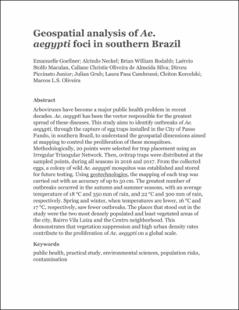| dc.rights.license | Atribución-NoComercial-SinDerivadas 4.0 Internacional (CC BY-NC-ND 4.0) | spa |
| dc.contributor.author | Goellner, Emanuelle | |
| dc.contributor.author | Neckel, Alcindo | |
| dc.contributor.author | Bodah, Brian William | |
| dc.contributor.author | Stolfo Maculan, Laércio | |
| dc.contributor.author | Oliveira de Almeida Silva, Caliane Christie | |
| dc.contributor.author | Piccinato Junior, Dirceu | |
| dc.contributor.author | Grub, Julian | |
| dc.contributor.author | Cambrussi, Laura | |
| dc.contributor.author | Korcelski, Cleiton | |
| dc.contributor.author | Silva Oliveira, Marcos Leandro | |
| dc.date.accessioned | 2022-09-30T00:45:39Z | |
| dc.date.available | 2023 | |
| dc.date.available | 2022-09-30T00:45:39Z | |
| dc.date.issued | 2021 | |
| dc.identifier.citation | Emanuelle Goellner, Alcindo Neckel, Brian William Bodah, Laércio Stolfo Maculan, Caliane Christie Oliveira de Almeida Silva, Dirceu Piccinato, Julian Grub, Laura Pasa Cambrussi, Cleiton Korcelski, Marcos L.S. Oliveira, Geospatial analysis of Ae. aegypti foci in southern Brazil, Journal of Environmental Chemical Engineering, Volume 9, Issue 6, 2021, 106645, ISSN 2213-3437,
https://doi.org/10.1016/j.jece.2021.106645. | spa |
| dc.identifier.uri | https://hdl.handle.net/11323/9546 | |
| dc.description.abstract | Arboviruses have become a major public health problem in recent decades. Ae. aegypti has been the vector responsible for the greatest spread of these diseases. This study aims to identify outbreaks of Ae. aegypti, through the capture of egg traps installed in the City of Passo Fundo, in southern Brazil, to understand the geospatial dimensions aimed at mapping to control the proliferation of these mosquitoes. Methodologically, 20 points were selected for trap placement using an Irregular Triangular Network. Then, ovitrap traps were distributed at the sampled points, during all seasons in 2016 and 2017. From the collected eggs, a colony of wild Ae. aegypti mosquitos was established and stored for future testing. Using geotechnologies, the mapping of each trap was carried out with an accuracy of up to 50 cm. The greatest number of outbreaks occurred in the autumn and summer seasons, with an average temperature of 18 °C and 350 mm of rain, and 22 °C and 300 mm of rain, respectively. Spring and winter, when temperatures are lower, 16 °C and 17 °C, respectively, saw fewer outbreaks. The places that stood out in the study were the two most densely populated and least vegetated areas of the city, Bairro Vila Luiza and the Centro neighborhood. This demonstrates that vegetation suppression and high urban density rates contribute to the proliferation of Ae. aegypti on a global scale. | eng |
| dc.format.extent | 1 página | spa |
| dc.format.mimetype | application/pdf | spa |
| dc.language.iso | eng | spa |
| dc.publisher | Elsevier BV | spa |
| dc.rights | © 2021 Elsevier Ltd. All rights reserved. | eng |
| dc.rights.uri | https://creativecommons.org/licenses/by-nc-nd/4.0/ | spa |
| dc.source | https://www.sciencedirect.com/science/article/abs/pii/S2213343721016225 | spa |
| dc.title | Geospatial analysis of Ae. aegypti foci in southern Brazil | eng |
| dc.type | Artículo de revista | spa |
| dc.identifier.url | https://doi.org/10.1016/j.jece.2021.106645 | |
| dc.rights.accessrights | info:eu-repo/semantics/embargoedAccess | spa |
| dc.identifier.doi | 10.1016/j.jece.2021.106645 | |
| dc.identifier.eissn | 2213-3437 | spa |
| dc.identifier.instname | Corporación Universidad de la Costa | spa |
| dc.identifier.reponame | REDICUC - Repositorio CUC | spa |
| dc.identifier.repourl | https://repositorio.cuc.edu.co/ | spa |
| dc.publisher.place | United Kingdom | spa |
| dc.relation.ispartofjournal | Journal of Environmental Chemical Engineering | spa |
| dc.subject.proposal | Public health | eng |
| dc.subject.proposal | Practical study | eng |
| dc.subject.proposal | Environmental sciences | eng |
| dc.subject.proposal | Population risks | eng |
| dc.subject.proposal | Contamination | eng |
| dc.type.coar | http://purl.org/coar/resource_type/c_2df8fbb1 | spa |
| dc.type.content | Text | spa |
| dc.type.driver | info:eu-repo/semantics/article | spa |
| dc.type.redcol | http://purl.org/redcol/resource_type/ART | spa |
| dc.type.version | info:eu-repo/semantics/draft | spa |
| dc.relation.citationissue | 6 | spa |
| dc.relation.citationvolume | 9 | spa |
| dc.type.coarversion | http://purl.org/coar/version/c_b1a7d7d4d402bcce | spa |
| dc.rights.coar | http://purl.org/coar/access_right/c_f1cf | spa |


